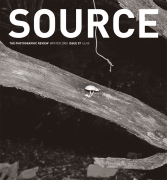Drawing on Street Photography
Dryden Goodwin: 'Cast' – The Photographer’s Gallery 26th September - 16th November 2008
Review by Lucy Soutter
Issue 57 Winter 2008
View Contents ▸
Dryden Goodwin’s exhibition Cast brings photography together with drawing in a series of uneasy hybrids. Made at night on London buses, trains and West End shopping streets, the images concentrate on the faces of passers-by. While some of the 5 bodies of work pit drawing and photography against each other as competing forms of visual documentation, the more striking images use drawing as a tool to underline the creepy, gnawing voyeurism at the heart of street photography.
Focused exclusively on the face, Goodwin’s drawing sometimes embellishes photographs, and sometimes stands on its own. The seven large-scale black and white portraits of Cradle have lines scratched into their faces with an etching needle. Shapeshifter features 690 quick sketches of train passengers, exhibited both as a grid of small drawings on paper and as a jumpy animation. Casting involves colour photographs accompanied by constellations of tiny repetitive drawings the artist has made from the faces of figures contained in them. For Caul, Goodwin scanned colour photographs of passengers on the upstairs decks of buses, and used a digital stylus to produce a web of luminous red lines over their faces, a process of tracing that becomes the subject of the final video piece Rock. Caul 6 (detail), 2008
Caul 6 (detail), 2008
The context of The Photographers’ Gallery tilts the reading of the mixed media installation back towards photography. In this setting, it does not seem perverse to read the images in relation to the tradition of street photography, and to note the skill with which Goodwin uses framing, focus and lighting to isolate and amplify the expressions of his subjects. In the Cradle images, he places each subject in the bottom half of the frame, taking advantage of soft focus to blow out the details of environment and create a stage. The scratches on the prints rupture our expectations for this kind of image. As Clive Scott notes in his book Street Photography, the genre is generally characterised by unselfconsciousness, spontaneity and quirky understatement. Goodwin’s scratches create a sense of overinvolvement with the image, a deliberate violation of the neutrality of the genre as well as of the actual print.
Some of the scratch marks in Cradle are calm and orderly, others crazed. The face of a South Asian woman in Cradle 10 has been incised with swirling calligraphic lines that evoke Arabic writing, while in Cradle 9 the scratches trace the contours of the nose, ear and eye of a bearded man with lines that reference life drawing. On one level, these scratches evoke science: the diagrams produced by tracking the movement of the human eye as it tries to read facial expression, with this much attention devoted to eyes, or mouth, or nose. On another level, the lines call up psychological or even supernatural uses of vision, the flickering obsessive glances of a stalker or of an enemy in the process of casting the evil eye. Casting - Nike (detail), 2008
Casting - Nike (detail), 2008
This disturbing quality of line is even clearer in the Caul figures, whose faces are scrawled with blood red lines. The edgy-looking short-haired man in Caul 6 is rendered demonic by frantic zigzags. In contrast, the face of the sleeping man in Caul 4 is covered with long loose airy swirls, perhaps a visual analogy for his dreaming state. Although the lines on the surface of the photographs do not have a clear representational function, it is almost impossible not to read them metaphorically, as referring to alienation, surveillance or violent urges. But whose? The style of drawing changes so much from image to image that it starts to seem like it might be pattern for its own sake.
Both street photography and life drawing have made claims to capturing the essence of their subjects. The tiny sketches in Shapeshifter reinforce this notion. In some cases the artist had managed to dash only the roughest outline of facial features, yet conveys a sense of vitality. In contrast, the heads in Casting have an arid, analytic quality. They have been drawn not from life, but from the artist’s photographs. This is the paradox at the heart of the show – the artist appears torn between responding to figures in the world and responding to his own creations. In the most satisfying works, the two impulses collide in defaced images of strange power. In between, however, too many of the works pull in too many different directions, giving the impression of incomplete experimentation, or a compulsion to produce work in series because it is expected. Cradle 10 (detail), 2008
Cradle 10 (detail), 2008
For ambitious contemporary photographers, it is not sufficient to pursue traditional subject matter with a traditional approach. Commissioning bodies and critics demand more, whether it is an up-to-date conceptual or theoretical subtext or some kind of technical or formal innovation. Commissioned by the Photographer’s Gallery and Photoworks, and soon to be a monograph published by Photoworks and Steidl, the five bodies of work in the exhibition Cast demonstrate a serious attempt to update street photography, bringing it together with an investigation of drawing in relation to the figure and the photograph. Clive Scott describes the street photographer as a petty criminal, a hit-and-run operator or black marketeer, trading in stolen moments. His or her strength is in finding human drama where others would find only banality. Goodwin embraces this role, and adds those of studio artist and researcher, producing moody images that seesaw strangely between the expressive and the analytical.
Other articles by Lucy Soutter:






